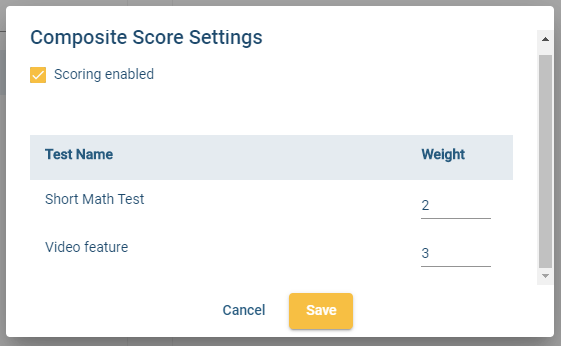A composite test score refers to a test score that is combined from the scores of multiple tests, that is, a test battery. The purpose is to create a single number that succinctly summarizes examinee performance. Of course, some information is lost by this, so the original scores are typically reported as well.
This is a case where multiple tests are delivered to each examinee, but an overall score is desired. Note that this is different than the case of a single test with multiple domains; in that case, there is one latent dimension, while with a battery each test has a different dimension, though possibly highly correlated. That is, we have four measurement situations:
- Single test, one domain
- Single test, multiple domains
- Multiple tests, but correlated or related
- Multiple tests, but unrelated latent dimensions
With regards to the composite test score, we are only considering #3. A case of #4 where a composite score does not make sense is a Big 5 personality assessment. There are five components (Openness, Conscientiousness, Extraversion, Agreeableness, and Neuroticism), but they are unrelated, and a sum of their scores would not quantify you as having a good or bad personality, or any other meaningful interpretation!
Example of a Composite Test Score
A common example of a composite test score situation is a university admissions exam. There are often several component tests, such as Logical Reasoning, Mathematics, and English. These are psychometrically distinct, but there is definitely a positive manifold amongst them. The exam sponsor will probably report each separately, but also sum all three to a total score as a way to summarize student performance in a single number.
How do you calculate a Composite Test Score?
Here are four ways that you can calculate a composite test score. They typically use a Scaled Score rather than a Raw Score.
- Average – An example is the ACT assessment in the United States, for university admissions. There are four tests (English, Math, Science, Reading), each of which is reported on a scale of 0 to 36, but also the average of them is reported. Here is a nice explanation.
- Sum – An example of this is the SAT, also a university admissions test in the United States. See explanation at Khan Academy.
- Linear combination – You also have the option to combine like a sum, but with differential weighting. An example of this is the ASVAB, the test to enter the United States military. There are 12 tests, but the primary summary score is called AFQT and it is calculated by combining only 4 of the tests.
- Nonlinear transformation – There is also the possibility of any nonlinear transformation that you can think of, but this is rare.
How to implement a Composite Test Score

You will need an online testing platform that supports the concept of a test battery, provides scaled scoring, and then also provides functionality for composite scores. An example of this screen from our platform is below. Click here to sign up for a free account.

Nathan Thompson earned his PhD in Psychometrics from the University of Minnesota, with a focus on computerized adaptive testing. His undergraduate degree was from Luther College with a triple major of Mathematics, Psychology, and Latin. He is primarily interested in the use of AI and software automation to augment and replace the work done by psychometricians, which has provided extensive experience in software design and programming. Dr. Thompson has published over 100 journal articles and conference presentations, but his favorite remains https://scholarworks.umass.edu/pare/vol16/iss1/1/ .
